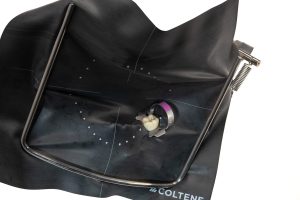Evaluating the barriers to rubber dam use in endodontics
Featured Products Promotional FeaturesPosted by: Dental Design 28th June 2023

The use of a rubber dam for endodontic treatment is crucial to effectively isolate the tooth, including the root canal, from bacteria, as well as protecting the patient’s airway.[i] Even though the rubber dam presents a range of benefits to the clinician and the patient, as well as improving surgical outcomes, many dentists choose not to use them after qualifying. Because of this, endodontic treatment may be performed without one.[ii] This decision brings with it a number of risks, so it is important that clinicians consider the regular use of rubber dams during endodontic treatment, and ensure that patients are informed of the benefits.
The risk of not using a rubber dam
Without the use of a rubber dam, the risk of a patient accidently swallowing or aspirating a dental instrument, irrigation fluid, or debris is significantly higher. This presents a number of issues for both the patient and the clinician. Injury can be caused to the patient, for example, if an instrument is swallowed and becomes lodged, or irrigation fluid (like NaOCl) is ingested, as it is an irritant. These risks can also present medicolegal challenges for clinicians.ii When a rubber dam is used, these potential problems are less  likely, and therefore you are protected from any legal responsibility if accidents happen.ii
likely, and therefore you are protected from any legal responsibility if accidents happen.ii
Cross contamination is another major risk when a rubber dam is not used during endodontic treatment. Because of this risk, the use of a rubber dam could be considered essential when carrying out endodontic treatment. A rubber dam creates a seal, separating the treatment area from the patient. This means that the patient will be unaffected by irrigating fluids and medicaments used during the procedure. Similarly, the treatment site is protected from any harmful bacteria present in the patient’s mouth. When this simple step is implemented, you protect yourself from litigation, and your patients from infection.i
Barriers to rubber dam use
Research shows that the majority of dental students expect that they will use rubber dams during treatment in practice, having used them as part of their education. However, the use of rubber dams appears to dramatically decrease post-graduation. In fact, endodontic treatment is generally performed without the use of a rubber dam.ii
Even though there are a multitude of benefits for both the patient and the practitioner, a number of reasons are given as to why rubber dams are not used during treatment. These include, lack of patient acceptance, more time needed for application, insufficient training/practice, difficult to use, as well as cost of materials and equipment.ii Even though these may be barriers in some cases, rubber dam placement is simple once the clinician has a good understanding of it. With proficient use of a rubber dam, clinicians will find application straightforward, and the process will become much faster.i
Those who use rubber dams frequently report that they face minimal patient resistance.ii A useful parallel to help patients understand the reasoning is that it isolates the operating site in the same way as a surgical drape, protecting the site from contamination. Once the reasoning behind the use of a rubber dam has been explained to patients, they are unlikely to reject it.i
Benefits of using a rubber dam
So, what are the benefits? In addition to protecting your patients from injury and infection, the use of a rubber dam results in significantly reduced microbial content of the aerosols produced during treatment.ii This is beneficial to the dental team as it reduces the risk of infection in the practice by up to 98.5%.i They also present the additional advantage of improved visibility and access to the treatment site as the rubber dam retracts the soft tissues, protecting them from injury, and making access to the field more straightforward. Visibility is also improved as they provide a dry field (which reduces mirror fogging) and creates a contrast.ii
aerosols produced during treatment.ii This is beneficial to the dental team as it reduces the risk of infection in the practice by up to 98.5%.i They also present the additional advantage of improved visibility and access to the treatment site as the rubber dam retracts the soft tissues, protecting them from injury, and making access to the field more straightforward. Visibility is also improved as they provide a dry field (which reduces mirror fogging) and creates a contrast.ii
The HySolate range of dental dams from COLTENE ensures complete isolation, crucial for providing effective and predictable dental treatment. Available in a range of colours and shades, including HySolate Black Edition, you can illuminate your site or create a clear contrast for excellent visibility. Plus, HySolate dental dams are available in a powder-free latex or a latex-free range to accommodate the needs of you and your patients.
Consider the use of a rubber dam for your endodontic treatment. They provide you with improved access to and visibility of the treatment site, helping to improve outcomes, while removing the risk of injury, contamination, and infection. This allows you to focus entirely on the treatment itself, rather than being concerned with protecting the patients’ airways and retracting the patients’ soft tissues.
![]()
For more on COLTENE, visit www.coltene.com,
email info.uk@coltene.com or call 0800 254 5115.
Mark Allen
Author: Mark Allen, General Manager at COLTENE
[i] Carrotte, P. Endodontics: Part 6 Rubber dam and access cavities. Br Dent J 197, 527–534 (2004). https://doi.org/10.1038/sj.bdj.4811799 https://www.nature.com/articles/4811799
[ii] Ahmad, I. A. “Rubber dam usage for endodontic treatment: a review.” International endodontic journal 42.11 (2009): 963-972. https://onlinelibrary.wiley.com/doi/pdfdirect/10.1111/j.1365-2591.2009.01623.x








